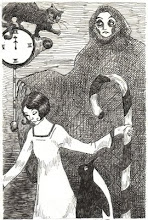
To add to my continuing series of blog posts on subjects that only I care about, I bring you my ode to one of my favorite fictional murderesses: Lydia Gwilt, from Wilkie Collins's 1866 novel Armadale. Collins is one of the very few men whose fictional murderesses are up to my (clearly) ludicrously high standards. And he is, by and large, criminally ignored and under-rated.
Armadale is one of the less frequently read of his four great novels of the 1860s (in addition to Armadale, they are The Woman in White, No Name, and the world's first detective novel, The Moonstone). There are interesting and well-rounded female characters in all of Collins's novels (including the first female detective in The Law and the Lady), but Armadale is my favorite.
It's a book about the sins of fathers being inherited (or not) by sons, and about dualities. There are at least four characters in the book named Allan Armadale. But villains are always (or often) more interesting than heroes. The villain of Armadale is Lydia Gwilt, the beautiful red-headed murderess at the center of all the action. Wilkie Collins was a free thinker and a feminist in a backwards and repressive age, and his villainess reflects this. Lydia was an adventuress who led a picturesque life full of murder and marriages and crime. She consorted with nobility, thieves, con-artists and abortionists. Her introduction in the novel is a glorious slow build. She is more or less properly introduced around page 185 via a letter from one of her confederates and doesn't truly enter the story proper until after page 300. But before that, right from the beginning of the novel, there seem to be shadowy females appearing everywhere. A wicked servant girl. A veiled figure. A failed suicide. The vision of a woman standing by the lake in a doom-laden dream. As readers, we only find out later that all these women are in fact Miss Gwilt.
I don't know that anyone could argue that she isn't monstrous, but she is wonderful, and oddly sympathetic at times. Her crimes don't spring out of any sort of delight in wickedness, but out of need and resentfulness and a true psychopath's version of expedience. The novel is partly epistolary, so we read lots about what is going on in her head from her letters and diary. The main body of the book takes place when young Allan Armadale has just come into his majority. His greatest friend is the dark and mysterious Ozias Midwinter who, it turns out, is actually Allan's biracial cousin, also named Allan Armadale, whose father (named, naturally, Allan Armadale) murdered young, rich Allan's father (no prizes for guessing his name!) many years previously. Got it? The fate of the two young Armadales is entwined with Lydia's through family history, wicked deeds and through the crazy prophetic dream of Midwinter's.
For my money, Wilkie Collins wrote some of the most entertaining books ever written. I don't know if it was the opium talking, but his imagination continuously veered off into weirdness that surpassed even his BFF Charles Dickens (except maybe for in Bleak House when that guy spontaneously combusts). His books are full of crime, murders, obese Italian super-villains with a fondness for white mice, intelligent women, legless mad geniuses, mental hospitals, abortionists, schemes, mad women, spying, cons, complex characters and an over-riding sense of social justice. I mean, how many other novels published in 1866 feature a black hero? How many novels published in the 19th century as a whole feature a black hero? He should be more widely read, and the main reason he is not is that he has been placed by the stuffy literary powers that be into the box called "entertainment" rather than the one called "literature", so the people who are most likely to enjoy his books often miss out on them entirely.

















No comments:
Post a Comment